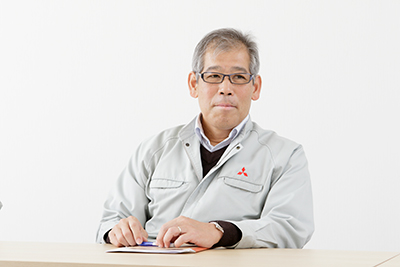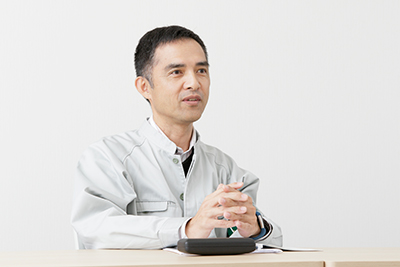Production launch at Mizushima: a challenge in assembling prototype on mass production line
After the kickoff rally, it was the time for the launch - to assemble the prototype model in the car assembly line at the mass production facility for the very first time. If successful, the costs incurred by shifting from trial phase to mass production will be significantly reduced because it uses the same assembly line with the mass production line. On the other hand, the live assembly lines for mass production are also used to assemble the existing models, which means it is difficult to go through a fine-tuning process to improve the quality (which is called "Hinshitsu-Gyokusei") and that it may adversely affect the production of existing models. But in the end, it turned out to be a great success where the very first prototype model has delivered the highest quality targets stipulated by Nissan Motor.

Mori, Project Manager
What was the key driver for achieving the high-quality targets without significant delays in a new Scheme both companies have never experienced before? Amid many factors, Mori PM (Project Manager), who took charge of supervising production processes in general, recalls that the most powerful driver was "great communication beyond corporate barriers". The effective, productive and frequent communication was underpinned by the intimate relationship where the management body and competent members are heading in the same direction. The activities known as QRQC (Quick Response Quality Control) and QRQE (Quick Response Quality Engineering) were underpinning their endeavors. In every morning and evening, the core members of Nissan and Mitsubishi meet face-to-face to share the latest status of the issues to make prompt strategic decisions. The activities also produced the side effect of creating a corporate culture that endorses its members to act proactively to find tasks that may be missed out and to clarify issues that may easily be left untouched.
Additionally, it was anticipated that a myriad of issues would arise from the new Scheme back from the point it was decided to build a prototype model in the live facility; that was why a set of teams were formed that are dedicated to resolve issues prior to the production. There were 21 teams of special purposes which missions vary from team building for quality improvement, awareness raising activities for the standard and criteria, and to taking measures to protect confidential information on the prototype assembling in the plant. Furthermore, it has adopted the method of "in-the-production-lot improvement" under the guidance of Nissan. The method aims to improve the quality on a daily basis by a parallel execution of building prototype models and making improvements within its trial production lot. This innovation significantly improved the level of quality in a short period of time.

Yokoyama, Deputy Project Manager, Administrative Department
When the first prototype model was deployed on the production assembly line, a total of 3,000 members of product development departments of Nissan, Mitsubishi, and affiliate companies gathered at Mizushima Plant. "The number of visitors was unprecedented." recalls Yokoyama Deputy Project Manager of the administrative department of Mizushima Plant, that the sheer number of visitors horrified him. It is not hard to imagine his feeling of surprise because a regular number of visitors at the time of mass production launch is less than ten or up to a few dozens. Many recalls that the scene was like a spectacular ceremony that all development personnel from many companies huddled around the prototype model and walked along the production line.
Takagi GM (General Manager) of NMKV, who supports the Project from a NMKV side, analyzed the underlying reason for the success beyond everyone's expectation, saying that the new model "emerged as an unsurmountable challenge to the product development team". The state-of-the art engine as well as continuously variable transmission (CVT) are installed in the new model which also enjoys the most advanced technologies adopted in its safety features and electrical appliances, all of which are literally comparable to the level of existing regular vehicles of Nissan. Almost all components have been developed anew. It has ignited a fire in the engineering spirits of members involved in the development and manufacturing because they naturally aspire to achieve development goals which difficulty is a lot higher from a technical perspective, which resulted to form a strong motivation for building mindsets focused on no other than the goal.

Takagi, General Manager
The challenge still continues until a decision is made in the evaluation meeting which participants will decide whether to proceed with the live migration to mass production or not. If the decision turns out to be "go" for the mass production, the new model will undergo the full-scale production at Mizushima Plant. "This is indeed crunch time for us", says Takagi GM humbly, but with a glare of confidence in his eyes.






